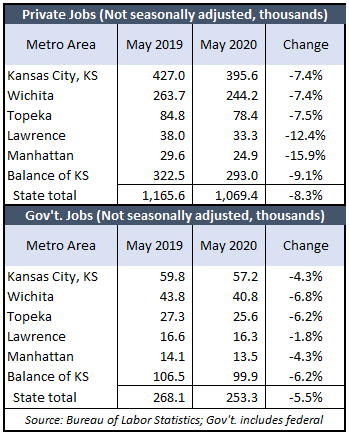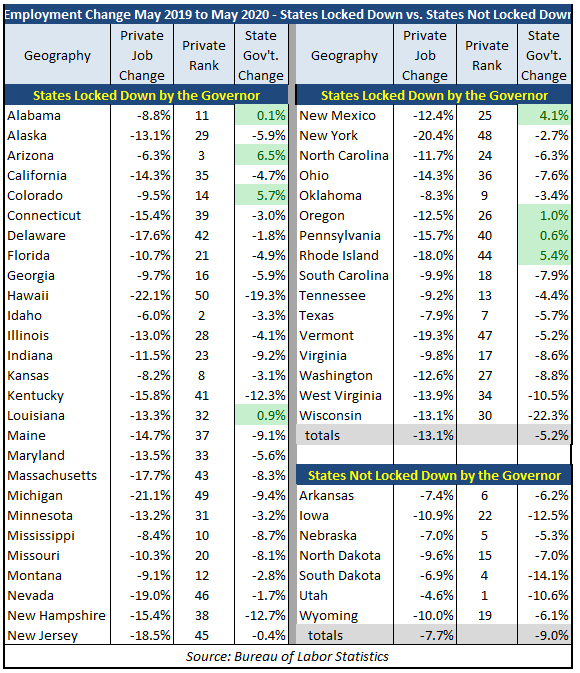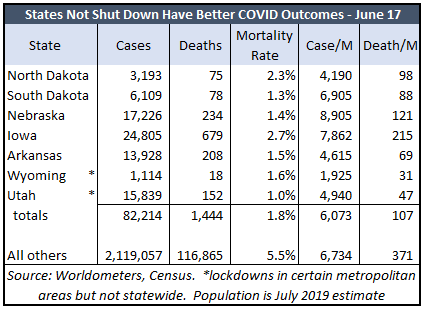Editor’s note: this story was revised on June 23 to reflect Oklahoma as being a locked-down state; we regret the error.
Employment data released today for May by the Bureau of Labor Statistics shows Kansas has about 107,000 fewer private-sector jobs than in February, prior to Governor Kelly’s mandatory shutdown order over COVID-19. At the same time, state government employment declined by just 200. Both comparisons are on a seasonally adjusted basis.
Compared to May 2019, there were about 95,000 fewer private-sector workers and 1,700 fewer state employees.
 There were 500 more federal government jobs and 5,400 fewer local government jobs in May.
There were 500 more federal government jobs and 5,400 fewer local government jobs in May.
Seasonally adjusted regional breakouts aren’t available, but without seasonal adjustment, private jobs declined by 8.3% statewide over the previous year. The Manhattan metro (down 15.9%) and the Lawrence metro (down 12.4%) suffered the greatest loss. The Kansas City and Wichita metros both lost 7.4%, the Topeka metro was down 7.5% and the rest of the state was off 9.1%.
Government jobs, including state, federal and local, declined 5.5% from a year ago. The Lawrence metro had the smallest decline at 1.8%. The metro areas of Kansas City and Manhattan both dropped 4.3%, the Topeka metro and the non-metro portion of Kansas declined 6.2%, and the Wichita metro lost 6.8% of its government workers.
States locked down during COVID have more job loss
Residents and business owners in states under a COVID shutdown mandate from their governors are suffering far more job loss. May private-sector employment in those 43 states was 13.1% lower than a year ago, but the states not shut down by their governors only lost 7.7% of their private job base.
 Utah was not under a statewide shutdown and has the smallest job loss, at 4.6%. Other states not shut down that had low job loss include South Dakota (6.9%), Nebraska (7%), and Arkansas (7.4%). North Dakota was down 9.6%, Wyoming lost 10% of its private-sector jobs, and Iowa had the worst loss among the states not shut down, at 10.9%.
Utah was not under a statewide shutdown and has the smallest job loss, at 4.6%. Other states not shut down that had low job loss include South Dakota (6.9%), Nebraska (7%), and Arkansas (7.4%). North Dakota was down 9.6%, Wyoming lost 10% of its private-sector jobs, and Iowa had the worst loss among the states not shut down, at 10.9%.
Hawaii suffered the largest private-sector decline among the shutdown states, 22.1%, followed by Michigan (21.1%), New York (20.4%), Vermont (19.3%), and Nevada (19%),
Thirty-two of the 43 states shut down suffered more than 10% private job loss.
The governors of those 43 states were much more protective of state employees, however. In fact, eight states – Alabama, Arizona, Colorado, Louisiana, New Mexico, Oregon, Pennsylvania, and Rhode Island – had more state employees in May than a year ago. New Jersey’s private sector was devastated with an 18.5% job loss, but state government jobs declined by just 0.4%.
None of the governors that didn’t lock their states down increased state employment levels. Collectively, the shutdown states had 5.2% fewer state government employees in May compared to a year ago, compared to a 9% decline in the seven states that weren’t shut down.
South Dakota Governor Kristi Noem took a lot of heat from national media for not closing her state, but her actions are positioning the state for a COVID economic recovery. With private job loss of just 6.9%, tax revenue loss should be must less than many other states; Governor Noem will also be better prepared to deal with tax loss, having reduced state government employment by 14.1%.
States locked down have worse COVID outcomes
 South Dakota also has a very low COVID mortality rate, at just 1.3% as of June 17. The seven states not shut down have an average COVID mortality rate of 1.8%, while the other states’ average mortality rate is 5.5%.
South Dakota also has a very low COVID mortality rate, at just 1.3% as of June 17. The seven states not shut down have an average COVID mortality rate of 1.8%, while the other states’ average mortality rate is 5.5%.
The states locked down by the governors also have more deaths per million of population (375 vs. 103), and South Dakota is even lower, at just 88 deaths per million.
COVID cases per million are also 11% higher in the states that were shut down, There are 6,791 cases per million in the states that were shut down and 6,073 in the other states.


